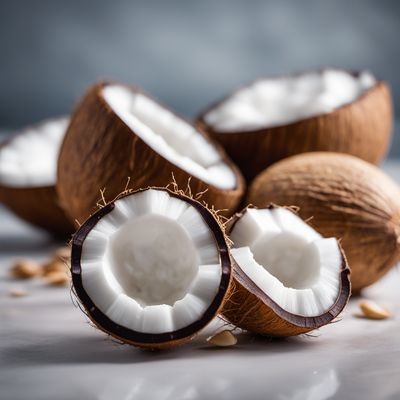
Ingredient
Coconuts and similar-
The Versatile Coconut
Coconuts and similar ingredients are characterized by their hard, brown outer shell and white, fleshy interior. The flesh can be consumed raw or used to extract coconut milk, oil, or shredded coconut. With a mildly sweet and nutty taste, coconuts offer a creamy texture that enhances both sweet and savory dishes.
Origins and history
Coconuts have a rich history and are native to tropical regions such as Southeast Asia, India, and the Pacific Islands. They have been a staple in the diets of these regions for centuries, providing nourishment and sustenance. Coconuts have also played a significant role in the cultural and religious practices of many communities.
Nutritional information
Coconuts and similar ingredients are a good source of healthy fats, fiber, and essential minerals such as manganese and copper. They are also relatively low in carbohydrates and contain no cholesterol. However, they are high in calories, so portion control is important.
Allergens
Coconuts and similar ingredients are considered tree nuts, and individuals with tree nut allergies should exercise caution when consuming them.
How to select
When selecting coconuts, choose ones that feel heavy for their size and have a firm shell. Shake the coconut to ensure there is liquid inside, indicating freshness. Look for coconuts with no cracks or mold on the shell.
Storage recommendations
To store a whole coconut, keep it at room temperature for up to a week. Once opened, store the coconut meat in an airtight container in the refrigerator for up to a week. Coconut milk or shredded coconut can be stored in the refrigerator for up to a week or frozen for several months.
How to produce
Coconuts can be grown in tropical regions with warm climates. They require well-drained soil and regular watering. However, growing coconuts from scratch can be a lengthy process, so it is recommended to purchase young coconut plants from a nursery.
Preparation tips
Coconuts and similar ingredients can be used in a variety of ways. The flesh can be grated and used in desserts, added to curries, or used as a topping for salads. Coconut milk is commonly used in soups, stews, and curries, while coconut oil is a popular cooking and baking ingredient. Shredded coconut is often used in baking or as a garnish for desserts.
Substitutions
Coconut cream or milk can be used as a substitute for dairy milk in recipes, while coconut oil can be substituted for butter or other cooking oils. However, the unique flavor and texture of coconuts may be difficult to replicate.
Culinary uses
Coconuts and similar ingredients are widely used in tropical and Asian cuisines. They are commonly found in dishes such as coconut curry, coconut rice, coconut shrimp, and coconut-based desserts like coconut macaroons or coconut custard pie.
Availability
Coconuts and similar ingredients are commonly available in tropical regions such as Southeast Asia, India, the Caribbean, and the Pacific Islands. They are also widely available in grocery stores and supermarkets worldwide.

